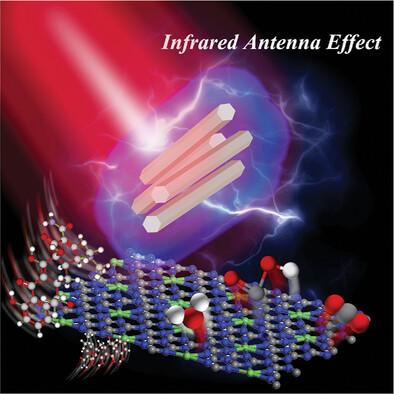Achieving Near Infrared Photodegradation by the Synergistic Effect of Z-Scheme Heterojunction and Antenna of Rare Earth Single Atoms
IF 13
2区 材料科学
Q1 CHEMISTRY, MULTIDISCIPLINARY
引用次数: 0
Abstract
Near-infrared light response catalysts have received great attention in renewable solar energy conversion, energy production, and environmental purification. Here, near-infrared photodegradation is successfully achieved in rare earth single atom anchored NaYF4@g-C3N4 heterojunctions by the synergistic effect of Z-scheme heterojunction and antenna of rare earth single atoms. The UV–vis light emitted by Tm3+ can not only be directly absorbed by g-C3N4 to generate electron–hole pairs, realizing efficient energy transfer, but also be absorbed by NaYF4 substrate, and generating photo-generated electrons at its impurity level, transferring the active charge to the valence band of g-C3N4, forming a Z-scheme heterojunction and further improving the photocatalytic efficiency. Importantly, Tm single atoms has multiple functions such as acting as charge transfer channels to facilitate charge transfer, regulating the critical distance of energy transfer, and prolonging electron–hole pair lifetime. Under NIR light, it exhibited remarkable performance in degrading antibiotics (the removal rate of TC reached 91% for 6 h) while maintaining excellent stability. The LC-MS/MS technology is used to reveal the reaction intermediates, active species, and reaction pathways, and the complex mechanism of photodegradation is further proposed. This study provides experimental and theoretical support for designing and synthesizing catalysts with near-infrared light response characteristics.

求助全文
约1分钟内获得全文
求助全文
来源期刊

Small
工程技术-材料科学:综合
CiteScore
17.70
自引率
3.80%
发文量
1830
审稿时长
2.1 months
期刊介绍:
Small serves as an exceptional platform for both experimental and theoretical studies in fundamental and applied interdisciplinary research at the nano- and microscale. The journal offers a compelling mix of peer-reviewed Research Articles, Reviews, Perspectives, and Comments.
With a remarkable 2022 Journal Impact Factor of 13.3 (Journal Citation Reports from Clarivate Analytics, 2023), Small remains among the top multidisciplinary journals, covering a wide range of topics at the interface of materials science, chemistry, physics, engineering, medicine, and biology.
Small's readership includes biochemists, biologists, biomedical scientists, chemists, engineers, information technologists, materials scientists, physicists, and theoreticians alike.
 求助内容:
求助内容: 应助结果提醒方式:
应助结果提醒方式:


